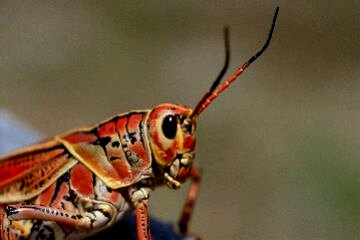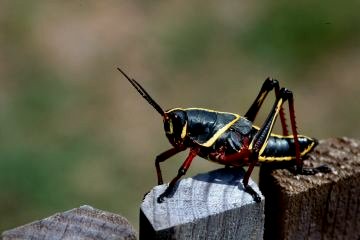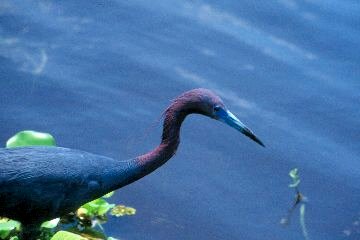Florida
2000
Sunday, April 30th
Woke up this morning and looked outside only to be greeted by a Rock
Dove. Hoped that this was not a portent of the day's birding. Things brightened
a bit when I went to the hotel parking lot and saw (among other birds) a
Black-throated Blue Warbler. My plans for the day were to spend a lot of time at
Loxahatchee NWR and then ???? On the way to the refuge I saw some Canada Geese -
a first for me in Florida. Just outside the refuge I came upon a Common
Nighthawk.
Clacks, clucks, chucks, chips, chirps, squawks and hammering greeted me even
before I entered the Cypress Trail. I immediately saw a Yellow-billed Cuckoo.
This was soon followed by a Pileated Woodpecker. It really is an amazing bird.
Big red crest, bold white wing patches on a black body. It stayed out in the open for quite a while -
circling the trees and flying from limb to limb. It was joined in the same tree
by a Red-bellied Woodpecker which seemed puny in comparison. Several American
Redstarts were also in the area. I investigated some strange squawks I
heard coming from the water and discovered a Green Heron. I had never heard it
make that sound before. The heron continued calling and was soon joined by
another heron. The new arrival displaced the first one and I thought that a
territorial dispute was occurring. However, the two herons soon flew side by
side to a nearby branch. I watched the two of them for quite some time.
I walked down the trail a little bit, but did not see much activity so I
decided to go on to the Marsh Trail. As I was driving out of the parking lot, I
saw a car with a license plate reading "CHKASAW." That rang a bell, so
I threw the car into reverse and pulled up to the other car and greeted Mac, a
friend from Prodigy and now a member of the B.A.R.B. at SongStar group. We
talked a little while - he suggested that I go to a place I had never heard of
Wakodahatchee Wetlands - a water treatment area. I took down the instructions so
I could go there after I was done with Loxahatchee.
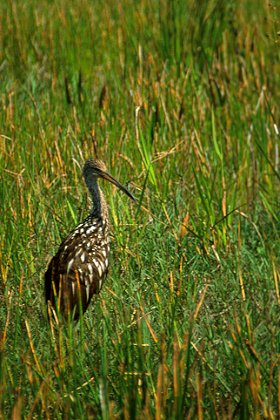 |
Said goodbye to Mac and went to the
Marsh Trail. As I entered the trail, I saw a Limpkin on my
right and a Sandhill Crane on my left. Which to photograph? I started with the
Limpkin. Took several pictures and then turned my attention to the crane
which decided to fly off before I got my camera aimed. Guess I made the
wrong decision. Later on, I was talking with a refuge volunteer who told
me that there had been two cranes for most of the winter at the refuge.
He said that they had been inseparable but that one had disappeared. He
surmised that a gator had gotten it.
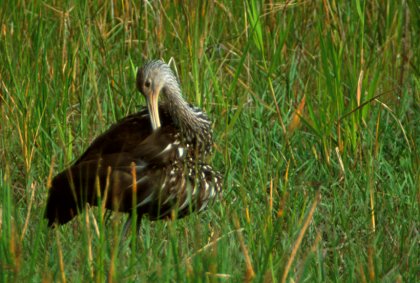 |
Took some more pictures of the Limpkin and then continued down
the trail. Saw the usual suspects - Anhingas, Boat-tailed Grackles, White Ibis,
Glossy Ibis, Great Blue Herons, Great Egrets, Common
Moorhens, American Coots
among others. Also a few elegant Black-necked Stilts. Added Tricolored Herons to
the trip list and a Pied-billed Grebe.
|

Common Moorhen |
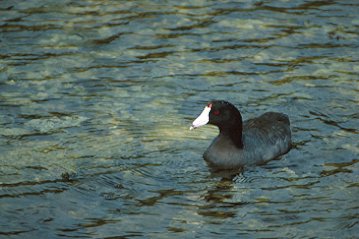
American Coot |
|
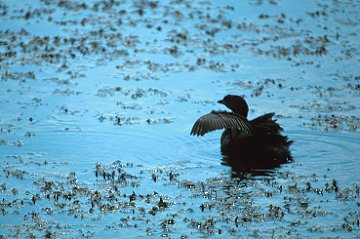
Pied-billed Grebe |
As I walked along the trail, I came to a tree that was full of
Anhingas - a few of which were white immatures. I
came to the observation tower. Mac had told me that I might be able to see a
Red-shouldered Hawk nest from it. Climbed the tower and found what I thought was
the nest, but couldn't be sure. It was very pleasant up there - a nice breeze
cooled me off. I stayed on the tower for quite a while. Observed a Loggerhead
Shrike on top of a sign. Just stayed and watched the birds. Saw a Little Blue
Heron changing plumage - mostly white but with a few blue splotches. I heard the
keer of the Red-shouldered Hawk - it flew by the tower but away from the nest. A
large flock of Glossy Ibis flew by - nice to see them at eye level. Heard the
Red-shouldered Hawk again, this time flying towards the nest but being pursued
by a Red-winged Blackbird. I did not see it go to the nest. The volunteer (I
mentioned before) joined me on the platform and we talked and watched a while.
We saw a large alligator heading for a Purple Gallinule that was on the shore.
It appeared that it was trying to sneak up on it. The gallinule flew off. The
alligator moved on towards a Common Moorhen which saw it but did not move. There
must be some distance that the moorhen felt comfortable with since it moved off
a little bit whenever the alligator got "close" but the moorhen did
not fly off. I admired the graceful flight of the Great Blue Heron. Listened to
the assorted sounds coming from the marsh. Mostly the squawks of moorhens and
the calls of grackles and blackbirds. Then we noticed the Red-shouldered Hawk at
the nest. It was feeding chicks but we could not see any. The volunteer told me
where I "might" be able to see the ani (same place that you mentioned
Carole) and I set out to find them. But first I stopped to take pictures of some
huge, colorful grasshoppers that were on a wooden stand by the platform.
Although the pictures look quite different, they are of the same species. The
one pictured on the left is an adult; the one on the right is the larval stage.
I carefully looked at every Boat-tailed Grackle but could not turn even one
of them into a Smooth-billed Ani. As I was looking, a small bird with buffy wing
patches flew by. It took me a second or two to realize that it was a Least
Bittern, a bird I had seen only three times before. I searched the reedy area
that it flew into but could not relocate it. As I was leaving the Marsh Trail, I
saw a Purple Gallinule standing just a little too far away for good pictures.
Then it flew right up to the water; well almost right up to the water. It stayed
just behind the grasses and just out of sight. I waited about fifteen minutes
for it to come out then finally decided to move on. Back to the Cypress Trail
where I was rewarded with excellent looks at Common Yellowthroat, American
Redstart, and Black-throated Blue Warblers. I had been hearing a
"wheep" in the area. When I finally saw the Great-crested Flycatcher I
knew that I should have recognized the sound. In the parking lot, I heard
another call. I could never find the bird that made it but while looking found a
Black-and-white Warbler.
I then went up to the dike area - another place that Smooth-billed Anis may
hang out. Didn't find one there either but did see a good assortment of herons.
One highlight was watching a Little Blue Heron hunting from a distance of about
ten feet. Very nice.
Stopped to admire some Black-necked Stilts and then left the refuge after spending about 6 hours there.
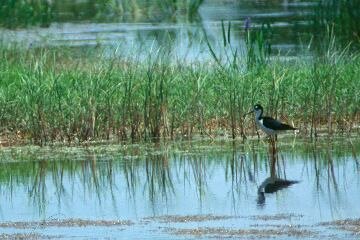
The First Florida Page
Sunday Birding at
Wakodahatchee
 Go to the SongStar home page
Go to the SongStar home page
Drop me a note
© 2000 Richard L. Becker





